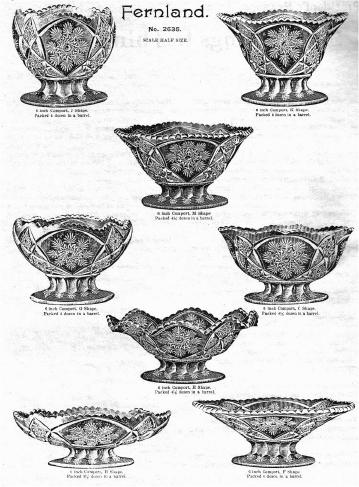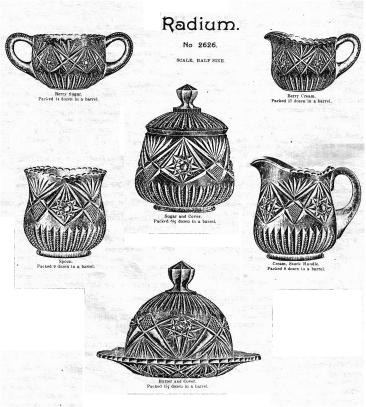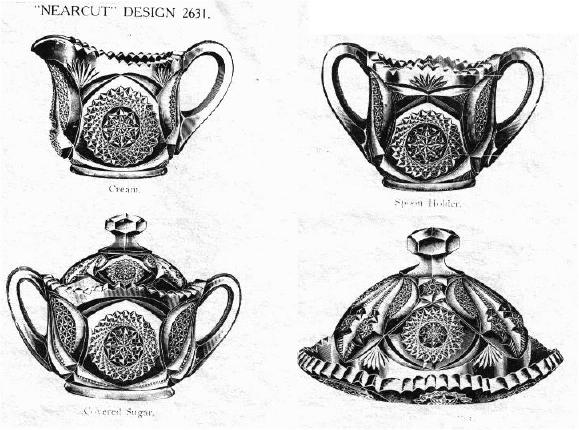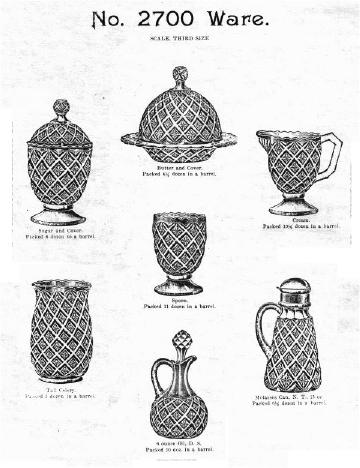How It All Began, Part I
by Mark Nye
Issue No. 280 - August 1996
At the NCC Convention this past June, I received a request for an article on Near Cut or the Near Cut era. It's been awhile since there has been such an article, so this month we travel back in time to 1902. Before we begin, perhaps a word or two about the term "Near Cut" is in order for novice readers.
Written as one or two words, Nearcut or Near Cut, the term is a trademark used both on glass and in print by Cambridge starting around 1903-1904. It was designed to describe the ware Cambridge was making that imitated, and often quite well, actual cut glass. The Near Cut era lasted until the early 1920s when the Cambridge lines changed and a new trademark, the familiar C in a triangle was developed.
In the beginning, Cambridge was owned by National Glass Company and it was they who built the factory and hired Arthur J. Bennett to operate the facility for them. Construction began in 1901 and production commenced at the completed Cambridge Glass Co. factory in May 1902. Construction of the factory was chronicled in the trade journals, including China, Glass and Lamps (CGL). The following quotes, all taken from CGL, take us through the final months of construction and the start of Cambridge Glass Co. production.
"The National Glass Co.'s two important plants under construction were expected to be in operation this month. The Rochester works have the foundation and steel girders for the first floor in place with a small portion of the frame for the first story erected. Their Cambridge plant has the building erected and the majority of the machinery installed..."
CGL Feb. 2, 1902
"Arthur J. Bennett, who left New York to take the presidency of the Cambridge Glass Co., Cambridge, Ohio, says that there is every prospect that the factory will be making glass early next month. Severe weather and the difficulty in obtaining building material retarded progress, but now everything seems to be going ahead. He says the factory is about as near perfect as can be, and with natural gas and good shipping facilities they will be able to hold their own with any of the other factories."
CGL March 20, 1902
"The Cambridge plant of the National Glass Co., it is now announced by its managers, will be completed and making glass on May 1. It will make general lines of glassware, tumblers, tableware, etc. It is a three furnace plant and one of the most complete extant."
CGL April 10, 1902
"Thos. G. Edge, who will handle in this market <New York City - Ed. note> the product of the Cambridge Glass Co., has just received their catalogue. It contains 140 pages of cuts, which include about everything that is made in table glass. It is expected that in another week the factory will be turning out ware."
CGL April 27, 1902
"The Cambridge Glass Works, a model three furnace plant with every modern improvement, commenced making glass this week."
CGL May 8, 1902
By September 1902 Cambridge advertisements were appearing in the trade journals. The first known advertisement appeared in the September 25, 1902 issue of CGL. Without illustrations, its text read:
"A. J. Bennett, President. The Cambridge Glass Co. Cambridge, Ohio, Manufacturers of Pressed and Blown Tableware and Specialties. We also operate the Canton Glass Works and make the full line of Druggists' glassware, Fish Globes, Cake Covers, etc. Catalogs and Price Lists mailed on application. Special attention to the making and working of Private Moulds. Pressed Vault, Sidewalk and Skylight Glass. New York Agency - Thos. G. Edge, 66 West Broadway. Resident agents in all the large cities. Traveling salesman in every State. Write us and we will have our salesman call upon you." (Capitalization in this and other ad copy is that used by Cambridge.)
This same advertisement then appeared in the next five issues of CGL.
A new advertisement appeared in the November 6, 1902 issue of CGL and it ran for four more weeks, ending with the December 4 issue. It stated the Cambridge Glass Co. was a manufacturer of high-grade tableware and specialties, druggist glassware, etc. It also listed the names and addresses of nine agents where samples could be seen. New York, Philadelphia, Baltimore, Chicago, Indianapolis, St. Louis, Kansas City (MO), Denver, and San Francisco all had resident Cambridge agents as 1902 came to a close.
The December 11, 1902 Cambridge advertisement in CGL read:
"The Cambridge Glass Co. Cambridge, O., manufacturers of Pressed and Blown Glassware of every description. Special reasons why you should be interested in us: This factory produces the highest class of glassware. We make prompt shipment and give our trade every consideration and attention. The variety is immense and the capacity equal to the demand. Our new catalog of regular table glassware and druggist specialties will be ready in January. Make your application and we will put your name on the mailing list, and we will also keep you posted on new additions to our line from time to time."
No additional advertisements appeared in CGL until January 1904 when Line No. 2626 or Radium as well as the "Near-Cut" trademark first appeared in the January 21, 1904 issue. The list of cities having show rooms now numbered 12. Denver and Indianapolis had been dropped but added were Pittsburgh, Buffalo, Cincinnati, Portland and Seattle.
"Something Entirely New for 1905 in Near Cut Glass. It's the Acme of Glassmaking. Jobbers and first-class retailers must have it. Samples will be ready January 1st, 1905. Made Exclusively by The Cambridge Glass Co. Cambridge, Ohio." Thus read a full-page advertisement in the December 15, 1904 issue of CGL.
At the 1905 Pittsburgh Exhibit, the Cambridge Glass Co. had two rooms at the Monongahela House hotel. "In 41 and 42, three lines of new table patterns are displayed by Arthur Bennett of the Cambridge Glass Co. Two are heavy imitation cut, and one a kind of basketwork pattern. The figures are new and in harmonious proportions." CGL Jan. 12, 1905
One of the lines described in the preceding paragraphs is No. 2631 or Marjorie as it appeared in a full page advertisement in the February 9, 1905 issue of CGL with the caption "We invite you to inspect our New Line of 'Near-Cut' Glass out for 1905. It is a fine line of heavy pressed glass, the nearest to cut glass ever made. The metal is of clear crystal and of very brilliant finish. Don't fail to see it." Without line numbers or names it is impossible to say with certainty what the other two line numbers may have been. Fernland with a line number of No. 2630 is a good candidate as is No. 2700 for the "basketwork pattern."
To Be Continued ...




